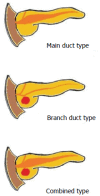Pathological features and diagnosis of intraductal papillary mucinous neoplasm of the pancreas
- PMID: 25232456
- PMCID: PMC4163729
- DOI: 10.4251/wjgo.v6.i9.311
Pathological features and diagnosis of intraductal papillary mucinous neoplasm of the pancreas
Abstract
Intraductal papillary mucinous neoplasm (IPMN) of the pancreas is a noninvasive epithelial neoplasm of mucin-producing cells arising in the main duct (MD) and/or branch ducts (BD) of the pancreas. Involved ducts are dilated and filled with neoplastic papillae and mucus in variable intensity. IPMN lacks ovarian-type stroma, unlike mucinous cystic neoplasm, and is defined as a grossly visible entity (≥ 5 mm), unlike pancreatic intraepithelial neoplasm. With the use of high-resolution imaging techniques, very small IPMNs are increasingly being identified. Most IPMNs are solitary and located in the pancreatic head, although 20%-40% are multifocal. Macroscopic classification in MD type, BD type and mixed or combined type reflects biological differences with important prognostic and preoperative clinical management implications. Based on cytoarchitectural atypia, IPMN is classified into low-grade, intermediate-grade and high-grade dysplasia. Based on histological features and mucin (MUC) immunophenotype, IPMNs are classified into gastric, intestinal, pancreatobiliary and oncocytic types. These different phenotypes can be observed together, with the IPMN classified according to the predominant type. Two pathways have been suggested: gastric phenotype corresponds to less aggressive uncommitted cells (MUC1 -, MUC2 -, MUC5AC +, MUC6 +) with the capacity to evolve to intestinal phenotype (intestinal pathway) (MUC1 -, MUC2 +, MUC5AC +, MUC6 - or weak +) or pancreatobiliary /oncocytic phenotypes (pyloropancreatic pathway) (MUC1 +, MUC 2-, MUC5AC +, MUC 6 +) becoming more aggressive. Prognosis of IPMN is excellent but critically worsens when invasive carcinoma arises (about 40% of IPMNs), except in some cases of minimal invasion. The clinical challenge is to establish which IPMNs should be removed because of their higher risk of developing invasive cancer. Once resected, they must be extensively sampled or, much better, submitted in its entirety for microscopic study to completely rule out associated invasive carcinoma.
Keywords: Branch duct intraductal papillary mucinous neoplasm; Intraductal papillary mucinous neoplasm; Main duct intraductal papillary mucinous neoplasm; Mucinous pancreatic cysts; Mucins.
Figures










Similar articles
-
MUC2 expression and prevalence of high-grade dysplasia and invasive carcinoma in mixed-type intraductal papillary mucinous neoplasm of the pancreas.Pancreatology. 2013 Nov-Dec;13(6):583-8. doi: 10.1016/j.pan.2013.08.007. Epub 2013 Aug 30. Pancreatology. 2013. PMID: 24280573
-
Intraductal papillary mucinous neoplasms of the pancreas with distinct pancreatic ductal adenocarcinomas are frequently of gastric subtype.Ann Surg. 2013 Jul;258(1):141-51. doi: 10.1097/SLA.0b013e31828cd008. Ann Surg. 2013. PMID: 23532108
-
Frequency of subtypes of biliary intraductal papillary mucinous neoplasm and their MUC1, MUC2, and DPC4 expression patterns differ from pancreatic intraductal papillary mucinous neoplasm.J Am Coll Surg. 2012 Jan;214(1):27-32. doi: 10.1016/j.jamcollsurg.2011.09.025. Epub 2011 Nov 23. J Am Coll Surg. 2012. PMID: 22112419
-
Thirty years of experience with intraductal papillary mucinous neoplasm of the pancreas: from discovery to international consensus.Digestion. 2014;90(4):265-72. doi: 10.1159/000370111. Epub 2015 Jan 10. Digestion. 2014. PMID: 25591885 Review.
-
Pancreatic tumors with cystic dilatation of the ducts: intraductal papillary mucinous neoplasms and intraductal oncocytic papillary neoplasms.Semin Diagn Pathol. 2000 Feb;17(1):16-30. Semin Diagn Pathol. 2000. PMID: 10721804 Review.
Cited by
-
Clinical and Pre-Clinical Evidence of Carbonic Anhydrase IX in Pancreatic Cancer and Its High Expression in Pre-Cancerous Lesions.Cancers (Basel). 2020 Jul 22;12(8):2005. doi: 10.3390/cancers12082005. Cancers (Basel). 2020. PMID: 32707920 Free PMC article. Review.
-
Clinicopathological Features of Intraductal Papillary Mucinous Neoplasms of Pancreas in a Tertiary Care Center: A 14 Year Retrospective Study.J Clin Diagn Res. 2016 Aug;10(8):EC10-3. doi: 10.7860/JCDR/2016/20226.8296. Epub 2016 Aug 1. J Clin Diagn Res. 2016. PMID: 27656444 Free PMC article.
-
Improving Pancreatic Cyst Management: Artificial Intelligence-Powered Prediction of Advanced Neoplasms through Endoscopic Ultrasound-Guided Confocal Endomicroscopy.Biomimetics (Basel). 2023 Oct 19;8(6):496. doi: 10.3390/biomimetics8060496. Biomimetics (Basel). 2023. PMID: 37887627 Free PMC article. Review.
-
Intraductal papillary-mucinous carcinoma with portal vein tumor thrombus and multifocal liver metastasis: An autopsy case.Mol Clin Oncol. 2021 May;14(5):101. doi: 10.3892/mco.2021.2263. Epub 2021 Mar 13. Mol Clin Oncol. 2021. PMID: 33815792 Free PMC article.
-
Pancreatic resection for intraductal papillary mucinous neoplasm- a thirteen-year single center experience.BMC Cancer. 2016 Nov 4;16(1):844. doi: 10.1186/s12885-016-2887-8. BMC Cancer. 2016. PMID: 27809876 Free PMC article.
References
-
- Bosman FT, Carneiro F, Hruban RH, Theise ND (eds) WHO Classification of Tumors of the Digestive System. Lyon: IARC Press; 1997. pp. 279–337.
-
- Hamilton SR, Aaltonen LA (eds) WHO Classification of Tumors. Pathology and Genetics of Tumors of the Digestive System. Lyon: IARC Press; 2000. pp. 219–251.
-
- Furukawa T, Klöppel G, Volkan Adsay N, Albores-Saavedra J, Fukushima N, Horii A, Hruban RH, Kato Y, Klimstra DS, Longnecker DS, et al. Classification of types of intraductal papillary-mucinous neoplasm of the pancreas: a consensus study. Virchows Arch. 2005;447:794–799. - PubMed
-
- Hruban RH, Takaori K, Klimstra DS, Adsay NV, Albores-Saavedra J, Biankin AV, Biankin SA, Compton C, Fukushima N, Furukawa T, et al. An illustrated consensus on the classification of pancreatic intraepithelial neoplasia and intraductal papillary mucinous neoplasms. Am J Surg Pathol. 2004;28:977–987. - PubMed
-
- Maguchi H, Tanno S, Mizuno N, Hanada K, Kobayashi G, Hatori T, Sadakari Y, Yamaguchi T, Tobita K, Doi R, et al. Natural history of branch duct intraductal papillary mucinous neoplasms of the pancreas: a multicenter study in Japan. Pancreas. 2011;40:364–370. - PubMed
Publication types
LinkOut - more resources
Full Text Sources
Other Literature Sources
Research Materials
Miscellaneous

